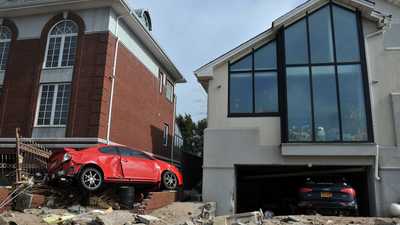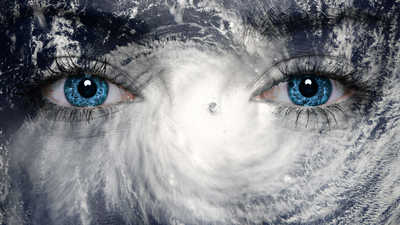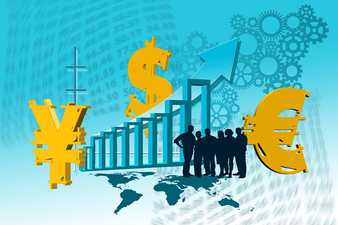| Home | About | Archives | RSS Feed |

The Independent Investor: The Price Tag of Disaster
 |
| Damage from Superstorm Sandy back in 2012. |
Over the past four weeks, just two hurricanes have cost the country upwards of $300 billion. This has easily surpassed the 2005 hurricane cost of $200 billion, which included Katrina, Wilma and Rita combined. The cumulative cost of weather continues to escalate and with good reason.
Before you leap to the conclusion that global warming is the culprit, let me lay out some facts. Coastal storms are no more (or less) frequent an event now than they have been throughout our history. So what gives?
The answer lies in population growth and demographics within our own society. A few years ago, a study funded by the National Oceanic and Atmospheric Administration, found that although hurricane intensity varied decade to decade, there has not been a spike in either the number or intensity of hurricanes, nor is there any evidence that global warming is the culprit.
The study pinned the blame for the elevated level of property damage and deaths on the growing concentration of people and property in coastal hurricane areas.
Today, well over 55 percent of the nation's population lives in roughly 673 coastal counties. That's over a 30 percent increase since 1980. The Southeast had the largest rate of change, with a 58 percent increase during that time. The Pacific region and the Northeast are also seeing the same phenomena. At this point, over half of us are crowded together on only 17 percent of America's land mass (excluding Alaska). As a result, some catastrophe modeling companies predict that losses because of coastal storms will double every decade or so due to this trend.
Where there are people, there is also infrastructure — roads, bridges, ports, schools, hospitals, etc. There are also businesses such as stores, restaurants, factories, movies and the like.
Finally, there are homes, from hi-rise condos and apartment buildings to row after beachfront row of single and multi-family dwellings. More than 55 percent of the nation's housing stock sunbathes along our coasts. This social migration is happening all over the world. Whether scientists look at Europe, Asia or anywhere in between, the results are the same. People are deliberately putting themselves and their property in harm's way at an alarming rate.
Today, when even a middling hurricane makes landfall, the chances of $1 billion in damages and greater loss of life is higher than ever before.
The same can be said for earthquakes, according to FEMA. Its studies found that although the number and intensity of earthquakes have stayed the same (more or less) over the last hundred years, damage has skyrocketed due to "significant growth in earthquake-prone urban areas and the vulnerability of older building stock, including buildings constructed within the last 20 years."
At some point, when the cost of insuring "home, sweet home" on our nation's coastal areas grows to be greater than your mortgage payments, the trend will reverse, or at least we hope so. But in the meantime, as long as one keeps wishing for that place by the shore, the economic costs will continue to grow. It's your move, America.
Bill Schmick is registered as an investment adviser representative and portfolio manager with Berkshire Money Management (BMM), managing over $200 million for investors in the Berkshires. Bill's forecasts and opinions are purely his own. None of the information presented here should be construed as an endorsement of BMM or a solicitation to become a client of BMM. Direct inquiries to Bill at 1-888-232-6072 (toll free) or email him at Bill@afewdollarsmore.com.
The Independent Investor: America, the Battered
 |
Extreme weather and other climate disasters appear to be occurring far more frequently than we would like. The loss of life and economic damage also seem to be increasing. But does the data support those opinions, and if it does, what price do we pay for all of these perfect storms?
Long-time readers may recall my columns of four and five years ago, where I examined the price tag the world (and the U.S.) pays for weather-related disasters. Given the fact that we are between hurricanes (Harvey has departed Texas, while Irma bears down on Florida); it may be a good time to educate new readers on the economic cost; not to mention the loss of life.
In 2016, the U.S. suffered twice the amount of weather-related economic damage versus the prior year, according to the National Oceanic and Atmospheric Administration (NOAA). Weather and climate were responsible for 297 deaths and $53.5 billion in damage in 2016. Fifteen of these events cost at least $1 billion and covered 38 states.
In 2015, the costs were $21.5 billion. If you look back even further, over the past six years, there were at least 66 extreme weather events in the U.S. with a price tag of $1billion or more. Weather-related events caused 1,628 fatalities and $297.6 billion in economic losses throughout 44 states.
And now let's see what has happened so far in 2017. As of July 7, there have been nine weather events of $1 billion or more across the country, which caused 57 people's lives. And then came Harvey. Estimates so far put the price tag at $190 billion in damage with an additional 70 lives lost.
While Hurricane Irma, which some call "the largest storm in modern history" has yet to make landfall, most forecasters predict it will hit Florida dead-on by this weekend. Assuming it does, the economic damage could easily exceed $100 billion. No one knows how many lives will be lost. But by the end of this month, we could easily see as much as $300 billion in damages from these two events. And in the wings, Hurricane Jose and Katia are strengthening in the Atlantic.
If the magnitude and number of disasters appears unprecedented, it is because they are. Back in the Eighties and Nineties, according to the National Climatic Data Center, which is part of NOAA, it was rare to see more than two or three $1 billion, weather-related damage events annually. We had many years where the losses totaled less than $20 million a year. But today, billion-dollar events have become twice as frequent as they were back in 1996 as well as in the proceeding 15 years.
Looking at the time period from 1980-2016, the average number of annual weather events, according to NOAA, was 5.5 events per year. For the most recent five years, we have had twice that many events. And this year we have already hit 11 (and possibly number 12) by this weekend.
Expense-wise, we have also witnessed a big up-tick in the economic cost of these catastrophes. In October 2012, Hurricane Sandy, the "Super Storm," hit the New Jersey, New York coast killing 131 people. The estimated damages peaked at $50 billion. Only weather catastrophes in 2005, the year of Hurricane Katrina, Wilma, Rita and Dennis, generated more deaths (2,000) and worse damage ($187 billion).
All of the above, however, is small potatoes considering that in just the last two weeks we face possibly more damage than all of these hurricanes combined. In my next column, I will examine some of the causes of both the increase in weather events, as well as the severity of the economic damage.
Bill Schmick is registered as an investment adviser representative and portfolio manager with Berkshire Money Management (BMM), managing over $200 million for investors in the Berkshires. Bill's forecasts and opinions are purely his own. None of the information presented here should be construed as an endorsement of BMM or a solicitation to become a client of BMM. Direct inquiries to Bill at 1-888-232-6072 (toll free) or email him at Bill@afewdollarsmore.com.
The Independent Investor: The Market's Half-Time Report
 |
Financial markets worldwide ended the first six months of the year much better off than they started. Here in the U.S., the Dow and the S&P 500 Indexes both gained 8 percent, while NASDAQ delivered 15 percent.
The Russell 2000, the small cap index, underperformed (up 4 percent) and the Transports gained 5 percent. All-in-all, it paid to be in large-cap, especially the large cap growth sector for the first half. At the same time, the Volatility Index continued to make new lows, despite the fact that at least half the investing population was/is worried and fearful of our new president's agenda.
All of the top 20 economies around the world are growing this year. That recovery is broadening out to include emerging markets as well. It's the best global growth investors have experienced in five years. And economic forecasts have continued to indicate gains, especially in Europe. While over in Asia, recession-ridden Japan has managed to gain ground (up 8 percent).
Their economy is stronger than at any time in the last 10 years.
As a result, international developed markets outperformed our own stock market. The French market gained 15 percent, Germany 16 percent, while Spain and Italy also gained by double digits.
Emerging markets have done even better, racking up a 17 percent gain. Individual countries like Hong Kong were up 16 percent, while China lagged (only up 12 percent). Most investors do not realize that the decline in the dollar since the beginning of the year had a lot to do with that overseas performance.
As the greenback fell, the foreign currency-denominated stock prices overseas gained.
Just this currency effect alone boosted foreign returns by 5 percent or more. If you subtract out the currency impact, foreign stocks actually lagged their U.S. counterparts, despite stronger economic growth. All of this was especially impressive given the political climate, as well as the changes in monetary policy here at home.
For years, investors have been concerned with what might happen to the stock market once the easy money policies of our central bank ended. Dire predictions of major declines caused by Fed tightening have not come true. Given that we have weathered three rate hikes since December and stocks are at or near record highs, says volumes about those overblown fears.
Two variables have saved the market from those bearish predictions. The economy and employment are both gaining with the jobless rate hitting historical lows over the last six months.
Low foreign interest rates have also kept a lid on rising rates here at home. Believe it or not, even at these low rates, foreigners are buying our bonds because interest rates and bond yields are much lower in their own countries.
But what about all this crazy partisan politics, tweets and the like, why hasn't this political turmoil decimated the markets as so many expected? Well, I come to discover (thanks to work done by Ned Davis Research, the Fed and Liz Ann Sonders, Charles Schwab's equity strategist), that "stocks rise faster when partisan conflict has been elevated on an absolute basis and relative to the recent past." There have been times since 1984 when the S&P 500 Index has made gains of 17 percent annually under these circumstances.
It simply proves that stocks do climb a wall of worry. But what is in store for us in the second half of the year? It appears that as long as the same set of circumstances prevails, we should have another strong year in the stock market. Let's hope they do.
Bill Schmick is registered as an investment adviser representative and portfolio manager with Berkshire Money Management (BMM), managing over $200 million for investors in the Berkshires. Bill's forecasts and opinions are purely his own. None of the information presented here should be construed as an endorsement of BMM or a solicitation to become a client of BMM. Direct inquiries to Bill at 1-888-232-6072 (toll free) or email him at Bill@afewdollarsmore.com.
The Independent Investor: Small Business Linchpin of America's Success
 |
The facts are that small businesses still create the lion's share of jobs and at least half the economic growth in this country. It would be wonderful if our lawmakers would finally realize that.
Look around you: with few exceptions, we are surrounded by entrepreneurs who have created over 60 percent of the jobs in our communities since the financial Crisis of 2009. What we don't see is the enormous burden that these heroes are living under on a daily basis.
A startup is largely a game of survival. Those who stay in business the longest are most likely to succeed. About two thirds of businesses only survive two years. Of them, another 50 percent will go under within five years. And only 33 percent will make it through ten years. The Labor Department, which supplied these statistics, found the same results across all industries.
The biggest challenges small business owners face is economic uncertainty, regulatory burdens, taxes and health-care costs. All but one of those obstacles depends on decisions that are largely made in Washington.
In recent small business surveys, a quarter of small-business owners said taxes are the most critical concern they face right now. As such, the outcome of the present debate in Washington over tax reform (or just plain tax cuts) will shape the actions of business owners in the future.
Most of us think in terms of tax cuts for the rich (or poor) but that is a simplistic way of looking at this issue. Tax cuts have far more impact on small businesses than on any single individual. Most small-business owners are neither rich nor poor. They are employers who plow back every cent they make into their businesses. As such, how many employees they hire and what they pay them has a direct relation to the taxes they pay.
If you think that these business owners would simply pocket the tax savings — think again. Many owners plan to funnel any tax savings they may receive into additional training and education. It is the entrepreneur's solution to the mismatch we have in this country right now between the demand for and supply of skilled labor.
A related issue is holding onto their existing labor force. Unemployment is at historical lows. More and more enterprises will find themselves in a bidding war for labor in a tightening job market. In order to hold on to his existing employees, owners also plan to raise wages with any new tax savings. The implication is that employees could receive a double whammy: their own individual tax cut plus a wage increase.
On the other end of the spectrum are Baby Boomer small-business owners that are looking to sell their businesses and retire. Most owners have plowed back every cent they have earned over the years into their businesses. Many have no IRAs or other tax deferred savings plans. Once again, taxes come into play. A lower capital gains tax can make a big difference to someone hoping to sell their company for a few million dollars.
Is it any wonder that new business creation in this country continues to decline? Entrepreneurial startups are at nearly a 40-year low. Part of the reason is structural. Internet shopping, companies like Amazon or Walmart, have gobbled up competitors, both large and small, in areas where the Mom and Pop store once thrived.
But rising taxes and a growing mountain of rules and regulations from federal, state and local governments threatens to finally kill America's goose that laid the golden eggs. The small-business person, faced with more and more licenses, fees and permits simply to get started are opting not to try.
Our new president, to his credit, has promised relief in just about every area that is near and dear to the hearts of entrepreneurial America. But so far, it has been all words but little action. I blame our bickering Congress for that.
Although increasingly frustrated by this inaction, small-business people, by their very nature, are a hopeful lot who still sees the glass as half full when it comes to Donald Trump. Let's hope they are not disappointed.
Bill Schmick is registered as an investment adviser representative and portfolio manager with Berkshire Money Management (BMM), managing over $200 million for investors in the Berkshires. Bill's forecasts and opinions are purely his own. None of the information presented here should be construed as an endorsement of BMM or a solicitation to become a client of BMM. Direct inquiries to Bill at 1-888-232-6072 (toll free) or email him at Bill@afewdollarsmore.com.
The Independent Investor: A Tale of Two Charities
 |
As Senate Republicans unveil their version of a new health care law replacing the Affordable Care Act on Thursday, Democrats are already crying foul. But while politicians are busy back-stabbing each other, there are real people out there who are sick and getting sicker.
These are Americans who can't afford, or can no longer find, insurance. Their stories are evidently not "newsworthy." Instead, the media prefers to accentuate the divisions among our lawmakers, while President Trump describes the House "Choice Act" as "mean." In the meantime, who is taking care of all those sick and elderly victims in this supposedly divisive America?
Well, the national, 90-clinic strong, Volunteers in Medicine (VIM) are doing their damdest to help.
"A national solution to America's uninsured," is the slogan of this the non-profit organization founded in 1994 by a physician, Dr. Jack McConnell, in Hilton Head, SC. They provide free medical, dental and other health-related services to all those who have no insurance and can't afford it. Sound familiar?
It should. In my last column, I wrote about the heroic volunteers of the Mercy Mission, a wholly-volunteer, charitable organization deep in Trump country that is doing a yeoman's job of providing the same — free dental and medical services to the poor and undocumented in Fort Worth, Texas.
This week, I visited a VIM clinic in Great Barrington in Berkshire County. Hillary Clinton once called Massachusetts "the Red Army of the Democratic Party." You can't get more liberal than Great Barrington. It is where Arthur Peisner, the local VIM chairman, oversees 150 volunteers that have provided 4,500 hours of clinical services this year alone to the undocumented, uninsured and poor residents in this hot-bed of liberalism. Since their founding in 2004, they have helped over 2,800 people in 30,000 clinic visits.
This particular VIM, in addition to medical and dental services, provides mental health, optometry, nutritional counseling, acupuncture and even therapeutic massage.
"We help whoever comes through our doors, however we can," says Peisner, who ran Lionel Trains Inc. for many years before retiring to the Berkshires 17 years ago.
His tireless Director of Medical Services Ilana Steinhauer is a firebrand whose compassion and support for the "have-nots" in our society is obvious. Like all their volunteers, she is committed to doing what our politicians can't or won't — helping those in need.
I tracked down Sasha Bianchi, the executive director of VIM's national organization, in Bernie Sander's home state of Vermont. To hear tell, everyone in Vermont wants universal health care and a society where government does everything. We talked about the myths that both liberals and conservatives hold about each other and how the press and political parties tend to perpetuate those ideas.
"We see none of that here nor anywhere else in the nation, and clinics are popping up everywhere," she said.
"But what about the idea, held by so many up here in liberal land, that people in places like staunchly Republican Texas, believe people should fend for themselves and all undocumented Mexicans should be arrested and booted back over the border?" I asked.
"All I can tell you is the facts," she said. "We've got more clinics opening up in Texas than anywhere else in the country."
The moral of this tale of two charities is quite obvious. Although we are led to believe that the tree-hugging liberals on both coasts want government to do everything, while they sit back and clip coupons, is no more true than every Republican Trump supporter is a die-hard, gun-toting, minority-hating, red-neck.
The truth is that most of us are loving people who are doing the exact same thing: caring in our own way for those less fortunate than ourselves. My advice is to ignore the myths of America that the politicians and media would have you believe. The volunteers at the Mercy Clinic and at VIM should be an example to us all. Put away your social media devices, roll up your sleeves, and go out there and help.
Bill Schmick is registered as an investment adviser representative and portfolio manager with Berkshire Money Management (BMM), managing over $200 million for investors in the Berkshires. Bill's forecasts and opinions are purely his own. None of the information presented here should be construed as an endorsement of BMM or a solicitation to become a client of BMM. Direct inquiries to Bill at 1-888-232-6072 (toll free) or email him at Bill@afewdollarsmore.com.

